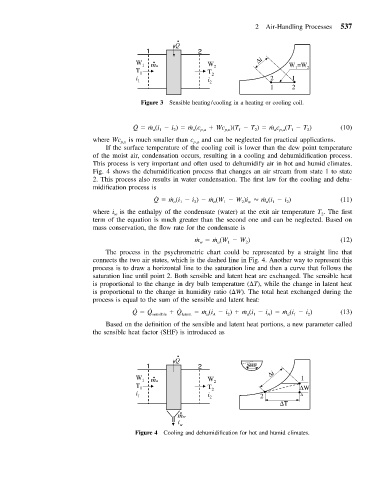Page 548 - Mechanical Engineers' Handbook (Volume 4)
P. 548
2 Air-Handling Processes 537
Q
1 2
∆i
W 1 m a W 2 W =W
T 1 T 2 1 2
i 1 i 2 2 1
1 2
Figure 3 Sensible heating/cooling in a heating or cooling coil.
˙
Q ˙m (i i ) ˙m (c p,a Wc )(T T ) ˙mc (T T ) (10)
2
p,v
1
a
a
1
2
1
ap,a
2
where Wc p,v is much smaller than c p,a and can be neglected for practical applications.
If the surface temperature of the cooling coil is lower than the dew point temperature
of the moist air, condensation occurs, resulting in a cooling and dehumidification process.
This process is very important and often used to dehumidify air in hot and humid climates.
Fig. 4 shows the dehumidification process that changes an air stream from state 1 to state
2. This process also results in water condensation. The first law for the cooling and dehu-
midification process is
˙
Q ˙m (i i ) ˙m (W W )i ˙m (i i ) (11)
a
a
1
w
2
1
2
1
a
2
where i is the enthalpy of the condensate (water) at the exit air temperature T . The first
w
2
term of the equation is much greater than the second one and can be neglected. Based on
mass conservation, the flow rate for the condensate is
˙ m ˙m (W W ) (12)
w
a
2
1
The process in the psychrometric chart could be represented by a straight line that
connects the two air states, which is the dashed line in Fig. 4. Another way to represent this
process is to draw a horizontal line to the saturation line and then a curve that follows the
saturation line until point 2. Both sensible and latent heat are exchanged. The sensible heat
is proportional to the change in dry bulb temperature ( T), while the change in latent heat
is proportional to the change in humidity ratio ( W). The total heat exchanged during the
process is equal to the sum of the sensible and latent heat:
˙
˙
˙
Q Q sensible Q latent ˙m (i i ) ˙m (i i ) ˙m (i i ) (13)
A
aA
1
a
2
2
a
1
Based on the definition of the sensible and latent heat portions, a new parameter called
the sensible heat factor (SHF) is introduced as
Q
1 2 SHF
∆i
W 1 m a W 2 1
T 1 T 2 ∆W
i 1 i 2 2 A
∆T
m w
i w
Figure 4 Cooling and dehumidification for hot and humid climates.

